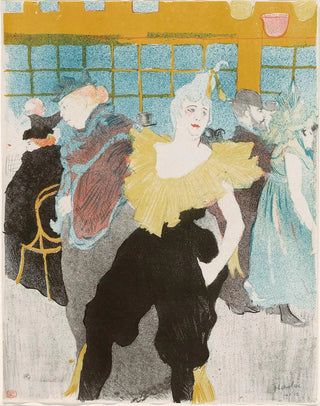Art print | Elles The Clownesse - Henri de Toulouse-Lautrec


View from behind

Frame (optional)
In the vibrant universe of Parisian cabarets at the end of the 19th century, Henri de Toulouse-Lautrec captured the very essence of nightlife through his art. Among his most iconic works, "Elles The Clownesse" stands out for its boldness and sensitivity. This canvas, depicting a clowness with painted face, evokes not only the world of entertainment but also the complex emotions surrounding it. The art print Elles The Clownesse - Henri de Toulouse-Lautrec allows you to grasp this fleeting moment of artistic life, offering a window into the ephemeral beauty of the Parisian scene.
Style and uniqueness of the work
"Elles The Clownesse" is characterized by a palette of vibrant colors and expressive strokes that reveal Toulouse-Lautrec's unique talent. The artist uses bold lines and stylized shapes to bring his subject to life—a clowness who appears both joyful and melancholic. The juxtaposition of humor and sadness in her expression immerses us in a universe where laughter often conceals tears. This duality is accentuated by the use of space, where the blurred background highlights the central character, giving her an almost magnetic presence. The composition, both dynamic and balanced, invites the viewer to explore the hidden emotions behind the mask of laughter. Toulouse-Lautrec, in his quest for artistic truth, manages to transcend mere representation, offering a reflection on identity and the role of artists in society.
The artist and his influence
Henri de Toulouse-Lautrec, an emblematic figure of Art Nouveau, marked his era with his sharp insight into the lives of artists and marginalized individuals. Raised in an aristocratic family, he quickly distanced himself from conventions to embrace the world of cabarets and theaters. His style, blending Japanese influences and Impressionism, revolutionized the way everyday life was depicted. By illustrating scenes of nightlife, he gave a voice to characters often forgotten by society, such as dancers, clowns, and prostitutes. His work inspired many 20th-century artists.

Matte finish

View from behind

Frame (optional)
In the vibrant universe of Parisian cabarets at the end of the 19th century, Henri de Toulouse-Lautrec captured the very essence of nightlife through his art. Among his most iconic works, "Elles The Clownesse" stands out for its boldness and sensitivity. This canvas, depicting a clowness with painted face, evokes not only the world of entertainment but also the complex emotions surrounding it. The art print Elles The Clownesse - Henri de Toulouse-Lautrec allows you to grasp this fleeting moment of artistic life, offering a window into the ephemeral beauty of the Parisian scene.
Style and uniqueness of the work
"Elles The Clownesse" is characterized by a palette of vibrant colors and expressive strokes that reveal Toulouse-Lautrec's unique talent. The artist uses bold lines and stylized shapes to bring his subject to life—a clowness who appears both joyful and melancholic. The juxtaposition of humor and sadness in her expression immerses us in a universe where laughter often conceals tears. This duality is accentuated by the use of space, where the blurred background highlights the central character, giving her an almost magnetic presence. The composition, both dynamic and balanced, invites the viewer to explore the hidden emotions behind the mask of laughter. Toulouse-Lautrec, in his quest for artistic truth, manages to transcend mere representation, offering a reflection on identity and the role of artists in society.
The artist and his influence
Henri de Toulouse-Lautrec, an emblematic figure of Art Nouveau, marked his era with his sharp insight into the lives of artists and marginalized individuals. Raised in an aristocratic family, he quickly distanced himself from conventions to embrace the world of cabarets and theaters. His style, blending Japanese influences and Impressionism, revolutionized the way everyday life was depicted. By illustrating scenes of nightlife, he gave a voice to characters often forgotten by society, such as dancers, clowns, and prostitutes. His work inspired many 20th-century artists.






